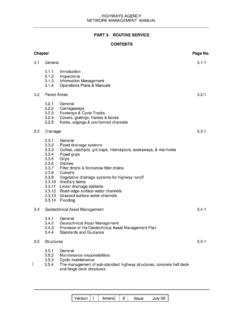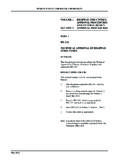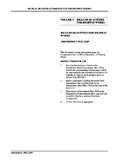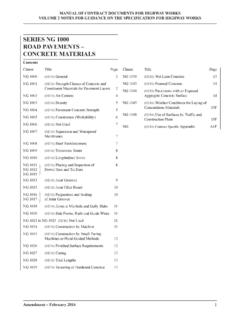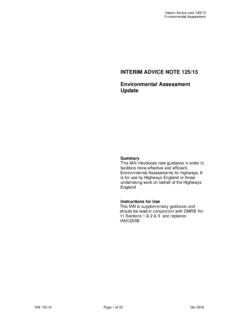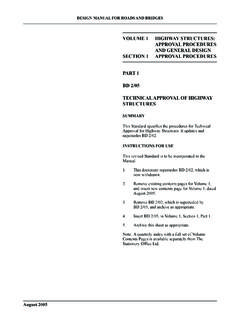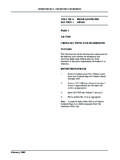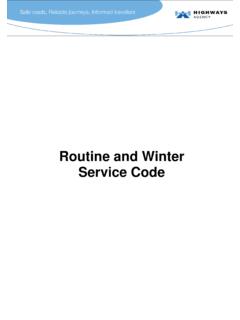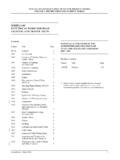Transcription of VOLUME 2 HIGHWAY STRUCTURES: DESIGN …
1 May 2017 DESIGN manual FOR ROADS AND BRIDGESVOLUME 2 HIGHWAY STRUCTURES: DESIGN ( substructures ) MATERIALSECTION 2 SPECIAL STRUCTURES PART 8BD 29/17 DESIGN CRITERIA FOR FOOTBRIDGESSUMMARYThis Standard specifies DESIGN criteria for footbridges for use by pedestrians, cyclists and FOR USE1. Remove existing Contents pages for VOLUME Insert new Contents pages for VOLUME 2 dated May Remove BD 29/04 from VOLUME 2, section 2, Part 8 and archive as necessary4. Insert BD 29/17 in VOLUME 2, section 2, Part Please archive this sheet as : A quarterly index with a full set of VOLUME Contents Pages is available separately from The Stationery Office manual FOR ROADS AND BRIDGESS ummary: This Standard specifies DESIGN criteria for footbridges for use by pedestrians, cyclists and Criteria for FootbridgesBD 29/17 VOLUME 2.
2 section 2 Part 8 HIGHWAYS ENGLANDTRANSPORT SCOTLANDLLYWODRAETH CYMRUWELSH GOVERNMENTDEPARTMENT FOR INFRASTRUCTURE NORTHERN IRELANDMay 2017 Registration of AmendmentsVolume 2 section 2 Part 8 BD 29/17 Amend NoPage NoSignature & Date of incorporation of amendmentsAmend NoPage NoSignature & Date of incorporation of amendmentsREGISTRATION OF AMENDMENTSMay 2017 Registration of AmendmentsVolume 2 section 2 Part 8 BD 29/17 Amend NoPage NoSignature & Date of incorporation of amendmentsAmend NoPage NoSignature & Date of incorporation of amendmentsREGISTRATION OF AMENDMENTSMay 2017 DESIGN manual FOR ROADS AND BRIDGESVOLUME 2 HIGHWAY STRUCTURES: DESIGN ( substructures ) MATERIALSECTION 2 SPECIAL STRUCTURES PART 8BD 29/17 DESIGN CRITERIA FOR FOOTBRIDGESC ontents1.
3 Introduction2. General Principles3. Layout4. Bridge Supports5. DESIGN Standards6. Dimensional Standards7. Parapets8. Enclosed Footbridges and Clearance Gauge9. Drainage10. Walkway Surfaces11. Lighting12. Requirements for Combined Use by Pedestrians and Cyclists or Equestrians13. Nomative References14. Informative References15. ApprovalAnnex A: Special requirements for Overseeing OrganisationsMay 20171/1 Chapter 1 IntroductionVolume 2 section 2 Part 8 BD 29/171. This Standard deals mainly with geometric and user requirements. Other DESIGN aspects such as strength and properties of materials are covered by other documents within the DMRB This Standard supersedes standard BD 29/04. It is to be used where appropriate in conjunction with the relevant Parts of the Eurocodes as implemented by the Overseeing Organisation except where otherwise specified by this The major changes to this document are as follows.
4 A) Removal and replacement of references to BS 5400 with references to the ) Removal and replacement of references to other withdrawn, obsolete or superseded standards with references to other current ) Minimum widths referred to in Chapter 12 have been updated in line with current This Standard must be used forthwith on all projects for the DESIGN , construction, assessment, operation and maintenance of motorway and all-purpose trunk roads (and all roads in Northern Ireland) except where procurement of works has reached a stage at which, in the opinion of the Overseeing Organisation, its use would result in significant additional expense or delay progress (in which case the decision must be recorded in accordance with the procedure required by the Overseeing Organisation) For the definition of the general HIGHWAY terms used in this Standard such as HIGHWAY types (trunk road, motorway etc) and components of the highways (carriageway, verge etc) refer to BS 6100.
5 Subsection Particular terms used in this standard are defined as follows:Desire Line Line likely to be taken by pedestrians, cyclists or equestrians finding the shortest route between two orientated users Users making a journey to reach a specific users Users making a journey for leisure Public right of way open to pedestrians, equestrians and A pedal A footway forms part of the road reserved for Lane/Cycleway A marked part of the footway or footbridge for use by 1 Introduction1/2 May 2017 Chapter 1 IntroductionVolume 2 section 2 Part 8 BD 29 This Standard specifies non-structural criteria for the DESIGN of footbridges for use by pedestrians, cyclists and equestrians, in urban and rural areas, which may be constructed of steel, aluminium alloy.
6 Reinforced or prestressed concrete, timber or other agreed Designers should be aware of the requirement to consider the needs of all users. The selection of specific DESIGN features that would exclude some users must be fully justified. (For example use of stairs instead of ramps will prevent use by wheel chair users) Guidelines for the selection of other suitable forms of pedestrian crossings are outside the scope of this Standard. However, TA 91 (DMRB ) Provision for Non-Motorised Users (Ref. 4) contains advice on the selection of appropriate NMU 20172/1 Chapter 2 General PrinciplesVolume 2 section 2 Part 8 BD 29/172. GENERAL This section describes the principles to be followed when designing footbridges. The underlying principle is that the designer is given the maximum flexibility to develop footbridge designs that will meet the stated objectives of the Overseeing The designer should balance the full range of considerations such as modes of users, safety, aesthetics, environmental impact, cost, robustness, sustainability, buildability, operation and maintenance.
7 Where there are options for alignment, layout and structural form, the selection process should include due consideration of these factors and any other relevant DESIGN constraint. The designer shall produce assessments covering equality impact, environmental impact and Health &Safety as part of their Footbridges can be more prone to various forms of damage, misuse and vandalism by users than road bridges and this shall be taken into account in the DESIGN and agreed with the Overseeing Organisation. See in particular paragraphs and below. Where there is a history of vandalism and/or graffiti, the designer shall ensure that the DESIGN reduces or mitigates the opportunity and likely impact of vandalism and graffiti on the structure and the visual aspect of the is important to recognise that engineering solutions to address non-engineering issues should not be routinely incorporated within a footbridge DESIGN , and should only be considered where there is an identified risk/history of incidents.
8 Where there is a significant history of localised incidents ( vandalism, suicide, anti-social behaviour, etc.) then a feasibility study should be undertaken, fully considering the risks and a range of mitigating actions. Designers should consider what reasonable measures could be implemented to address issues and agree these with the Overseeing Organisation. These could include local community and organisational initiatives, publicity campaigns, signage, improved surveillance, and specialist direct telephone lines. Engineering measures may also be considered, but only if other solutions are not feasible. Where appropriate consultation with relevant bodies such as the local police, neighbourhood watch, community groups, local health boards, Samaritans etc.
9 May be may be reduced on some existing footbridges by simple measures like clearing vegetation and providing more visibility. Providing higher or different types of parapets to prevent objects being dropped onto the carriageway, may also reduce visibility and increase the risk of unsighted antisocial behaviour. Similarly providing enclosures to deter or prevent stone throwing or suicide attempts may just displace the incidents to another location, whilst imposing additional risks and ongoing maintenance liabilities at the footbridge site. Significant engineering solutions are unlikely to be covered by current standards, and will require fully justified and agreed forms and materials vulnerable to damage by vandalism or fire, or by defacement by graffiti that would be difficult to remove, might be inappropriate in particular The designer shall ensure that where they have specified the use of materials or components which have a high value, either as a component or scrap, then measures shall be taken to minimise potential unauthorised removal.
10 Consideration may be given to tamper resistant fixings or to specific DESIGN features. However due attention must be given to the requirements for inspection and maintenance. Where specific measures require special tools, techniques or procedures then the designer shall ensure that full consideration is given to ensuring measures are effective throughout the required DESIGN life. These must be set out within the maintenance 2017 Chapter 2 General PrinciplesVolume 2 section 2 Part 8 BD 29/17 Provision of The principal purpose of footbridges is to facilitate and encourage walking and cycling whilst ensuring safety for all road users. The DESIGN of crossing provided shall therefore be such as to encourage people to use it, addressing the needs of all likely users, taking account of likely pedestrian flows and movements, and to encourage people to regard walking or cycling as an acceptable mode of The DESIGN shall address the needs of all users, including access for wheel chairs and mobility scooters, and people with prams and It is important to determine the user groups of the bridge and their main purpose before deciding on its location.
